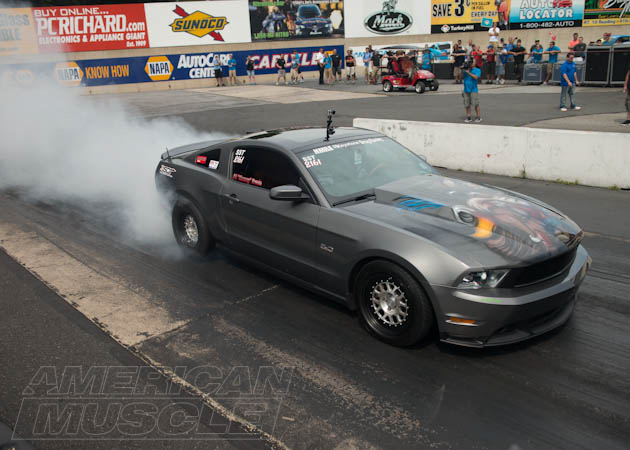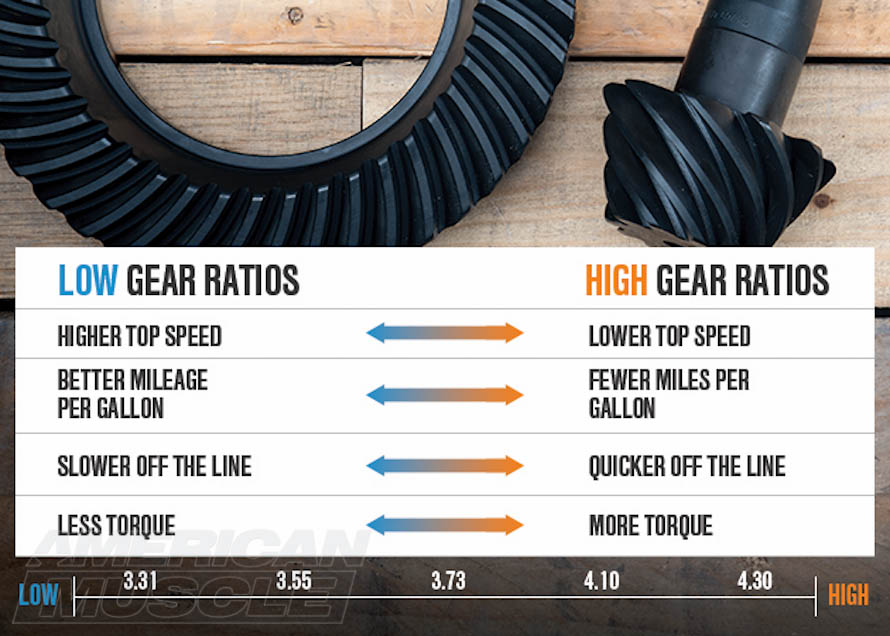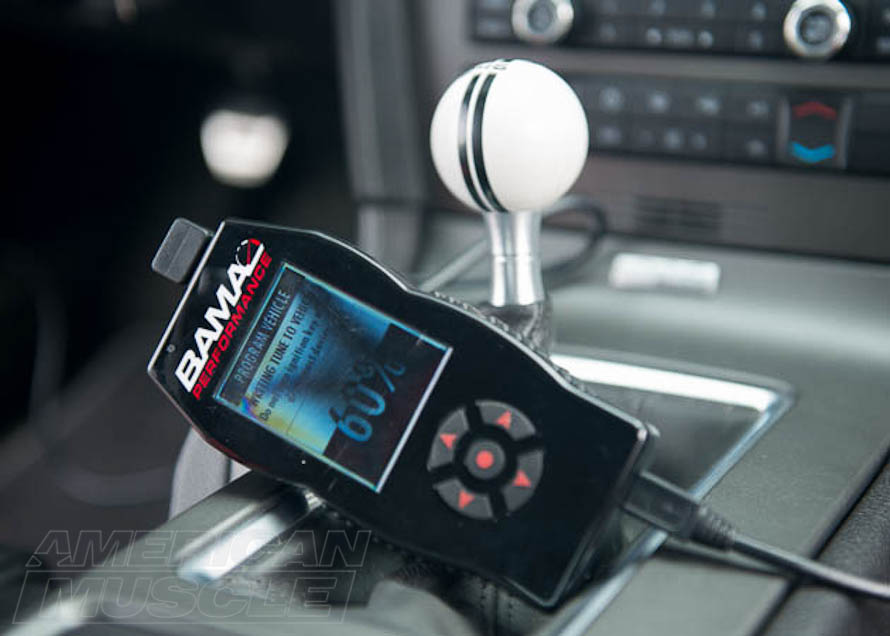A guide to help you understand the uses and benefits behind your Mustang's rear differential gears. Changing these gears will have a positive effect on both acceleration and fuel efficiency, depending on the ratio you choose. The increase in performance combined with the low cost means this is one of the best bang for your buck mods that you can do to your Mustang.
Shop Mustang Gears
Replacing the gears in your Mustang's rear differential will get you off the line and into the heart of the rpm band faster, cutting down 0-60mph times and make driving a whole lot more fun.
Mustang Gears >>
What Exactly Are Mustang Gears?
Gears can be a pretty general term but in this case, they refer to the ring and pinion gears residing in the rear differential. Your entire Mustang's rear consists of your axles, the gear housing, a power transfer device (IE a spool, LSD, posi-unit, etc.), and of course the ring and pinion gear set. Without getting too much into the technical details of how gears work, they convert the power coming from your driveshaft to power needed to turn your wheels.
Gears are referred to by ratios, such as 3.31 gears. This means the driveshaft needs to turn 3.31 times in order to turn your tires once. People upgrade to numerically higher gears because increasing this number gives your engine more leverage and makes it easier to accelerate faster. Higher gears, such as 4.10 gears, can be referred to as a steeper gear. A set of 4.10 gears will also result in a decrease of your top speed which is why they can also be referred to as shorter gears.
- Replacing a Mustang's stock rear gears with a higher ratio will give you quicker acceleration, greatly improving your 60 foot times--depending on what ratio you choose
- A ratio of 3.55 will get you down the drag strip quicker than most stock ratios, but 3.73s or 4.10s are an even greater improvement and so on
- Going with too extreme a gear ratio can result in lost traction and reduced top speeds, depending on your overall setup
- For a street car that might also see the track, 3.55s, 3.73s and 4.10s gears are recommended, with 4.10s being the gear of choice for automatic transmissions
- 3.73 vs 4.10 gears: 4.10s will let you experience quicker revs & lower gas mileage, but greater passing power on the highway (recommended shift point - 3,000 rpms)
As we’ve established the numerically higher the gear ratio is, the easier it is to get the vehicle moving and better accelerating, but subsequently lowers top speed. Why does it lower top speed? Keep in mind our V8 engines have a finite RPM limit. Consider this simplified example, where we do not take the transmission into consideration (for the sake of the example, the engine is connected directly to the differential). If the engine has a rev limit of 6000 RPM and the axle ratio is 3.08, then at 6000 RPM the wheels will be turning 1948 RPM (6000/3.08). Say the car had a numerically higher axle ratio of 3.55, then our final wheel speed would be 1690 RPM, which is less than the top speed of the 3.08 axle ratio.
Why Would You Want to Change Your Mustang's Gear Ratio?
There are many reasons, but the most common on a late model Mustang is to get your car into the power band faster, or like mentioned above, to accelerate faster. The cause for such sluggishness, at least for the late model Mustangs is when Ford switched from the 5.0L pushrod motor to the 4.6L modular motor. A common complaint was that the new motor was slower off the line. This is because the 4.6L does not start making its torque until higher up in the RPMs unlike the 5.0L. Changing to a steeper gear will get that pig out of its blanket, and really wake it up off the line.
By changing the ratio, you are not actually changing any power levels, but you are manipulating the available torque. This is why it’s considered the best bang for your buck mod. No actual power changes, but there can be a huge difference in performance and race times after swapping gears. If you are plenty happy with the way your Mustang drives, there is absolutely no need to change the rear gears.
What Gear Ratio Should I Buy?
Most owners tend to choose a 3.55, 3.73, or 3.90 for a Mustang that is daily driven. If you are serious about speed, then you might consider the 4.10 or a 4.30. However, the higher the ratio the faster you will accelerate, but it will also result in much higher engine RPMs when cruising on the highway (this handy gear ratio to RPM chart will show you what your Mustang's estimated RPMs will be at cruise). You'll also be sacrificing your top end speed and some fuel economy. If highway gas mileage is a major concern, a good compromise is a lower ratio such as 3.55 or 3.73. Also note changing your rear gear will affect your speedometer readings, and to correct them you will need a handheld tuner.
| Transmission |
2.73 Gears |
3.08 Gears |
3.55 Gears |
3.73 Gears |
4.10 Gears |
4.56 Gears |
| AOD / AODE Auto Trans |
1400 RPMs |
1650 RPMs |
1800 RPMs |
200 RPMs |
2300 RPMs |
2550 RPMs |
| 4R70W Auto |
1500 RPMs |
1850 RPMs |
2000 RPMs |
2250 RPMs |
2350 RPMs |
2600 RPMs |
| T5/T4 Manual |
| TR3650 Manual |
1450 RPMs |
1900 RPMs |
| TR6 Manual |
1200 RPMs |
1500 RPMs |
1600 RPMs |
1800 RPMs |
2150 RPMs |
2400 RPMs |
| MT-82 Auto & Manual |
1560 RPMs |
1750 RPMs |
2000 RPMs |
2150 RPMs |
2350 RPMs |
2600 RPMs |
For ‘Stangs equipped with an automatic transmission, it is recommended to go with either 3.73s or 4.10s. This is because the torque converter and different gear ratios inside the transmission itself. Automatic transmissions exhibit more slip and power loss due to their greater complexity, therefore a shorter gear is necessary to overcome these effects. Automatic cars tend to be heavier than their manual brethren, and thus suffer somewhat from that as well.
For heavily modified naturally aspirated engines, forced induction, and big-shot nitrous cars, what gear ratios to buy is actually a trick question. There are many factors that come into play, and it is best to talk to the shops that did the work on your engine, transmission, and chassis to find out what ratio to use.
Gearing for Performace: Autocross and Road Racing
Choosing gears for autocross/road racing can be similar, yet different from one another. One major item to consider is the course itself (one will primarily be racing on). The general idea is to remain in gear for the majority of the track; shifting as little as possible. Shifting consistently slows down times by not putting the power to the wheels. Somethings to consider for proper gear selection can be items as average course speed, distance, the degree of turns, etc.
3.73's tend to be a popular choice, but it really comes down to a variety of factors. Your best bet is talking to people with similar Mustang's to yours to get an idea what works best.
Some additional options to squeeze every little advantage out of a new gear install are to have the outer ring lightened. This process removes about 1 lb to 2 lbs of rotating weight. Other options include cryogenic treatment for some additional strength, and/or micro blue coatings that help in lubrication.
How Does Tire Size Effect Final Drive Ratios?
On a Mustang or any vehicle, tires work like gears do. This means that changing the tire height will impact how the final drive performs. Generally speaking, taller tires will make it act like a higher gear ratio and will even impact the vehicle's top speed capabilities. It can quickly become a balancing act as you want the car to launch harder, but a taller tire still offers more contact with the ground. If you have too much contact, the tires can possibly hook up enough to destroy axles.
Taller tires are also heavier and the gears will have to work harder to turn them. Ultimately, you want to consider how powerful the car is and what you need out of it. If it can take the beating and more top end is needed taller tires are a must, but for street/strip applications, you shouldn’t reach for the tallest tire you could fit in the wheelhouse.
What Gear Ratios Does My Mustang Have Stock?
Over the years, Mustangs have been offered with a myriad of gear ratios, so figuring out which ones are in your car can be tough. Especially with late model Mustangs, it can be difficult to figure out what gears your Mustang has since Ford has offered everything from 3.31s to 3.73s from the factory 2011 and up. Typically, the stock ratio is on the build sheet, or could be on a sticker on the door panel or glove compartment. You can also find the gear ratio stamped into the differential cover or written on to it from the factory, but these aren't always visible and can be difficult to locate. Using a VIN decoder can help and as a last resort you can go to a dealer and have them check to tell you.
If you suspect the gears already may have been changed, you can MacGyver it by jacking up the rear end, spin the tire one time and count how many revolutions the driveshaft made (it’s a good idea to use white-out or a sharpie to make a reference point on the driveshaft). Or, remove the differential cover and count the teeth. Just be sure you know what you are starting with. If you’re starting with 3.55s and feel they are not enough, it’s hard to say going with 3.73s will rock your world, as it is only an incremental step. Below is a breakdown of Mustang gear ratios by year:
| 1979-1993 (Foxbody) Mustang Stock Gear Ratios |
1994-1998 (SN95) Mustang Stock Gear Ratios |
1999-2004 (New Edge) Mustang Stock Gear Ratios |
2005-2009 (S197) Mustang Stock Gear Ratios |
2010-2014 (S197) Mustang Stock Gear Ratios* |
2015-2017 (S550) Mustang Stock Gear Ratios |
2018 (S550 Mustang Stock Gear Ratios |
| 2.26 (78-82 4.2L V8 automatics) |
2.73 |
3.27 (V6, GT, and '99-'01 Cobras) |
3.31 (All V6s, automatic GTs, and GT500s) |
2.73 |
3.15 (V6) |
3.15 (Automatic EcoBoost) |
| 2.47 (79 5.0L V8 automatics) |
3.08 (manual trans)* |
3.55 (Mach 1 and '03-'04 Cobras) |
3.55 (GT manuals) |
3.15 |
3.31 (V8 and EcoBoost) |
3.31 (Manual EcoBoost) |
| 2.73 (87-93 V8 manuals) |
3.27 (automatic trans)* |
|
|
3.31 (GT500s as well) |
3.55 (Performance Package)* |
3.55 (Automatic GT) |
| 3.08 (82-85 V8s)* |
|
|
|
3.55 |
3.73 (Torsen Perfromance Package) |
3.73 (Manual GT, GT350, and GT350R) |
| 3.27 (87-93 V8 automatics)* |
|
|
|
3.73 (2013 Track Pack and Boss models) |
|
|
| 3.45 (4cyl Turbos w/ 7.5" rear)* |
|
|
|
|
|
|
*1979-1993: The 3.08 rear gears also came in the 1993 Cobra. The 3.27 rear gears also came in the non-turbo, four cylinder engines with a 7.5" rear diff. The 3.45 rear gears DID NOT come in the 1985-1986 SVO. The manual turbo coupes came with 3.55 rear gears, but the automatic turbo coupes came with 3.73 rear gears.
*1994-1998: Cobras have 3.08 rear gears, but the Cobra R Mustangs came with 3.27 rear gears.
*2010-2014: The axle codes are as follows - BB is 3.73, CC is 2.73, DD is 3.55, GG is 3.31, and YY is 3.15.
*2015-2016: The 3.55 rear gears are options on the V6 and the V8, but 3.15 and 3.31 are the standard gears respectively.
Speedometer Calibration and Transmission Shift Points
Changing the gears will make your speedometer read incorrectly. This can be annoying and can get you in trouble with the law! Also if you have an automatic transmission this will cause your shift points to be incorrect and could cause some serious problems that could lead to transmission damage. There are several methods to correct these problems though.

17 Tooth Speedo Gear
Do I Need a Tune When Installing New Gears?
You have a couple of options as far as correcting your Mustang's speedometer and odometer reading. Depending on the year of your Mustang, the correction can be done by installing a speed calibrator, reprogramming with a chip or tuner, or installing the adjustment gear available through Ford racing.
A custom tune requires the use of a chip or handheld tuning device such as the SCT Eliminator, X3 PowerFlash, or LiveWire tuner. Your dealer will create a custom tune that specifically calibrates your speedometer and if you have an automatic, it will calibrate your transmission's shift points. This method will work on all Mustangs with computer controlled electronic gauges (1999 Mustangs).
SpeedCal Devices
A SpeedCal is an electronic device that allows you to adjust the signal being transmitted from your transmission to calibrate for gear changes. This works on Mustangs with both computer controlled electronic gauges and non-computer controlled electronic gauges (1994-2004 Mustangs).
Foxbody Speedometer Gears
If you have a 1979-1998 Mustang, replacing the speedo gear is a low cost option to correct your speedometer. The install is not too difficult and it’s important for safety considerations to get your speedo reading correctly. In order to help you find the correct gear for your ride, we have a helpful guide below and on all speedo gear product pages:
| Axle Ratio |
6 Tooth Drive Gear |
7 Tooth Drive Gear |
8 Tooth Drive Gear |
| 2.73 |
- |
16 |
18 |
| 3.08 |
- |
18 |
20 |
| 3.27 |
16 |
19 |
21 |
| 3.55 |
17 |
20 |
23 |
| 3.73 |
18 |
21 |
- |
| 4.10 |
20 |
23 |
- |
| 4.30 |
21 |
- |
- |
| 4.56 |
23 |
- |
- |
| Transmission |
16T |
17T |
18T |
19T |
20T |
21T |
| Manual |
Wine |
White |
Yellow |
Pink |
Black |
Red |
| Automatic |
Blue |
Green |
Gray |
Tan |
Orange |
Purple |
Mustang Transmissions and Their Speedometer Gears
Manual Transmissions with 7 Tooth Drive Gears:
- 1983-1989 T-5 OEM
- Pre 1993 T-5 Aftermarket
- 1996-1998 Cobra T-45 OEM
- All Tremec Transmissions
Manual Transmissions with 8 Tooth Drive Gears:
- 1990-1998 T-5 OEM
- 1996-1998 T-45 OEM Except Cobra
Automatic Transmissions with 7 Tooth Drive Gear:
- 1983-1989 Automatic Transmissions
Automatic Transmissions with 8 Tooth Drive Gear:
- 1990-1998 Automatic Transmissions
Bearings and Install Kits
If your Mustang is over or is close to 30,000 miles, your bearings are worn to your old gears. If you have less than 30,000 miles, it is generally accepted you can install gears using just the install kit and your current bearings. Personally, I always recommend getting the full install kit with new bearings and seals. It is cheap insurance to prevent having to replace your bearings and other parts the worn bearings damaged down the road.
VIDEO: 8.8in. Rear End Bearing Installation Kit Review
How Do I Install My Mustang's Gears?
Changing rear gears on any vehicle is a very complex task. While it is straight forward upon first glance, the precision and time it takes to complete the job can be overwhelming. If one does not utilize the proper equipment (measuring device, torque wrench, beam type torque wrench, slide hammer, etc) the job can be almost impossible to do correctly. If installed incorrectly, gears can have improper, premature wear. As a result from improper installation, they can also whine and be quite noisy. Improper installation is easier to accomplish than a correct install of the gears; a simple micrometer off the correct backlash can cause improper wear.
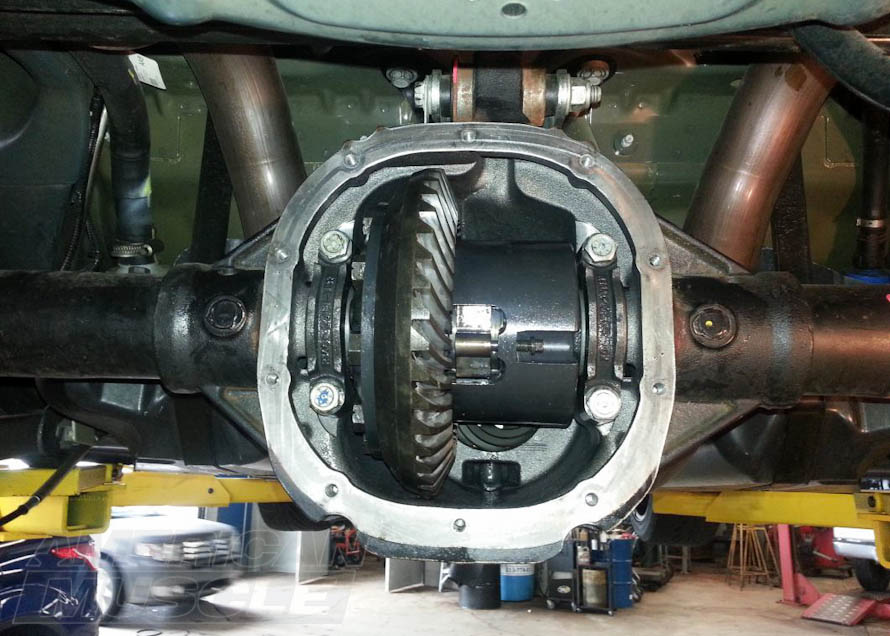
4.10 Gears Installed
Do I Need to Change My Mustang's Gear Oil?
After putting in the new gears, you’ll want to put fresh gear oil back in the differential. Make sure to use high quality synthetic gear oil to get maximum performance out of your Mustang. If you have a limited slip differential, Royal Purple comes with the friction modifier added, so you don’t have to get a separate bottle.
How Much Gear Oil Does My Diff Hold?
On Mustangs from 1986-2014 (with the exception of the 1999-2004 Cobras) utilize the 8.8 rear end. This fluid capacity is roughly 3 quarts (including a bottle of friction modifier). For 2015 and newer models, the fluid capacity is 1.6 quarts and 4 oz of fluid capacity. This does not apply to the GT350 as it holds slightly more fluid. On V6 models until 2011 (in 2011, they received an 8.8 rear end) the capacity is the same as the 8.8 counterpart.
What Size Rear End Does My Mustang Have?
- 1979-1985 V8s: 7.5
- 1986-2010 V6: 7.5
- 2011-2018 & EcoBoost: 8.8
- 1987-2018 Mustang GT and LX - 8.8
- 1999-2001 & 2003-2004 IRS Mustangs: 8.8
From 1979-1985 Mustang's came with the 7.5" rear. Up until 2011, the 7.5" was factory for everything without a V8. The 8.8" rear was the differential of choice for the V8 engines (4.6, 5.0, and the 5.4). After 2011 the 3.7L V6 and the Coyote powered Mustangs shared the 8.8". The Mustangs with IRS (Independent Rear Suspension) under them also came with the 8.8" rear end (99-01 and 03-04).
Granted, people change out the stock rear differentials for a number of reasons. One way to tell the difference is by the cover gasket and the pinion gear splines. The 7.5" rear has two flat edges on the gasket whereas the 8.8" is mostly round with two divots. Lastly, the 7.5" pinion has 28 splines, and the 8.8" has 30 splines.
Keep in mind if you have a 7.5 differential it can't accommodate 8.8 diff gears. You can, however, get the same ratios as those found in the 8.8 diffs. In other words, your V6 can house the same ratio as a GT.
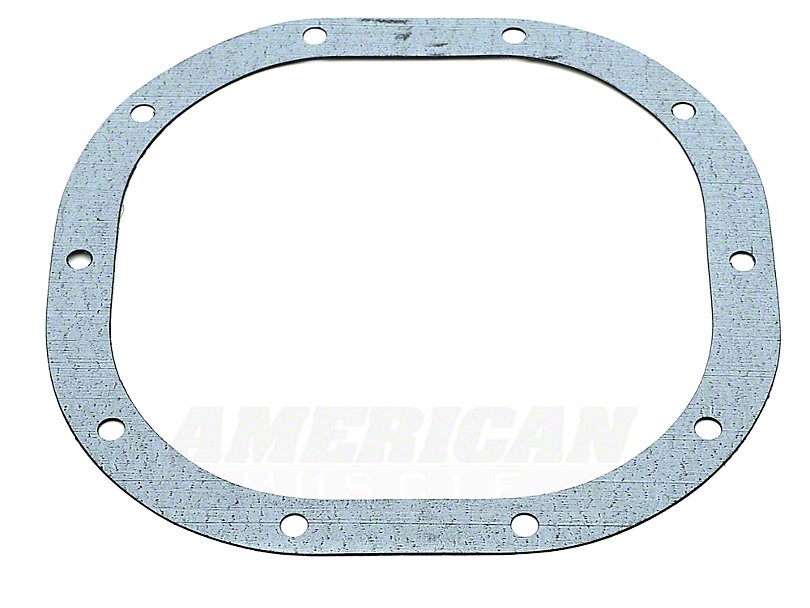
Differential Cover Gasket for 8.8in Diffs
Does My Mustang Come with an LSD from the Factory?
Up until 2011, all V6 models came with an open differential (in the 7.5) while V8 models came with an LSD (in the 8.8). After 2011, all models came with an LSD with the 8.8.
V6 Mustang Differentials and Interchangeability
Up until 2011, the V6 models had different rear ends than their 8 cylinder counterparts. A 2010 older V6 Mustang has a 7.5 rear end. As a result, they have their own gears (although the same size at the 8 cylinder 8.8 rear ends). Therefore, you can use V6 gears on all V6 Mustangs from 1994-2010. However, a 2011-2014 gear from a V6 will not be compatible with a 2010 and older model. V8 models use 8.8 rear ends and are interchangeable between all V8 models and V6 models from 2011 to the current production year.
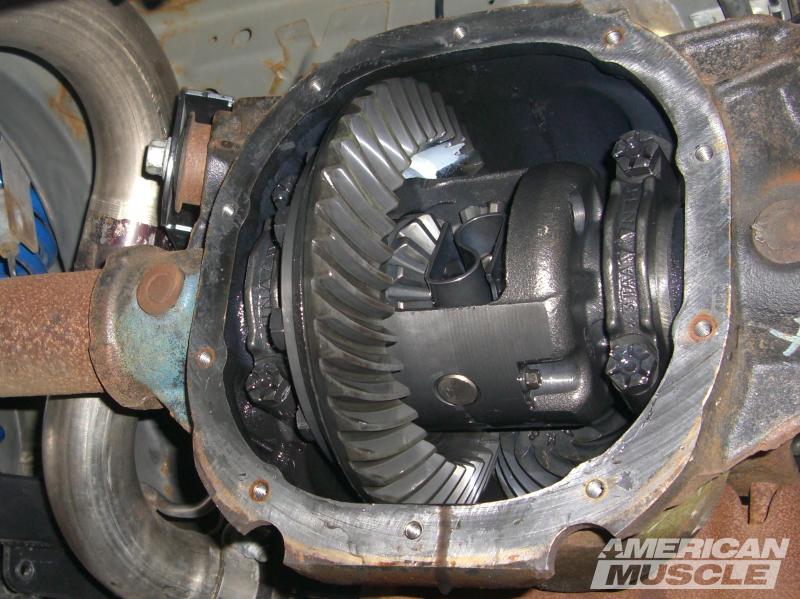
3.73 Ratio Ring and Pinion Installed in a 2010-2014 Differential
Should I Rebuild My Mustang's Rear Differential?
The whole point of a differential is to get power to tires with traction. Limited slip differentials make it so your Mustang can use both rear tires to push forward rather than one, making winter months a bit easier to deal with. LSDs are also popular for drifters since both tires spin in a drift which not only looks cooler, but makes it easier to swing out the back end. The easiest way to tell if your Mustang's LSD needs a rebuild is to do a burnout and have a friend tell you if both tires are smoking or if just one is spinning. If it's just the one, it's time for a rebuild.
Do I Want a Traction-Lok Rebuild Kit?
If you have a Mustang with Trac-Lok, have tried doing a burnout, and noticed only one of your wheels spinning, your Trac-Lok unit may need a rebuild. Having a worn out Trac-Lok won’t damage anything, but you could be losing out on some serious grip off the line if it’s not working as it should.
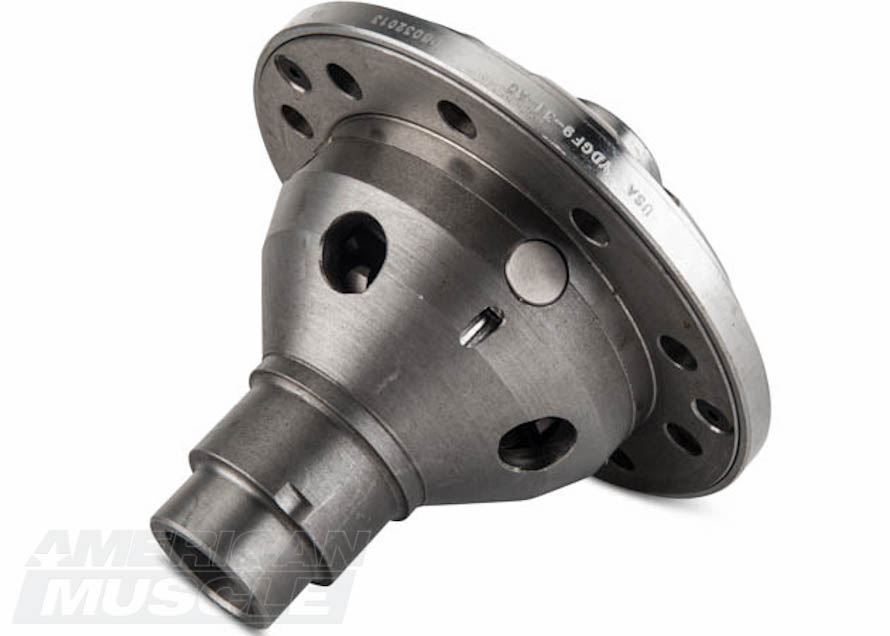
Limited Slip Differential
Fitment includes: 1979, 1980, 1981, 1982, 1983, 1984, 1985, 1986, 1987, 1988, 1989, 1990, 1991, 1992, 1993, 1994, 1995, 1996, 1997, 1998, 1999, 2000, 2001, 2002, 2003, 2004, 2005, 2006, 2007, 2008, 2009, 2010, 2011, 2012, 2013, 2014, 2015, 2016, 2017, 2018, 2019, GT, V6, Cobra, ShelbyGT500, Mach1, Bullitt, Boss, LX, SVO, EcoBoost, ShelbyGT350



